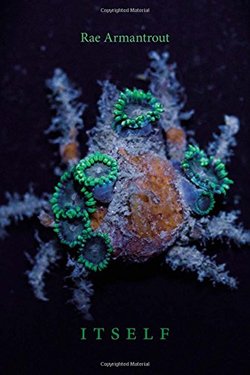
With its focus on the limited power of language to represent anything outside itself, Rae Armantrout’s poetry is a copywriter’s nightmare. In their publicity for this, Armantrout’s twelfth collection, Wesleyan’s publicists bravely describe the poems as “deft and audacious,” “exhilarating and unforgettable.” I’m not sure how they arrived at such emphatic words, unless perhaps they read the poems as audacious in their minimalisms, exhilarating in their indirections, deft in their avoidance of continuities, unforgettable in their understatements and in their risking of concluding stanzas that are even more understated and obliquely connected than the ones they follow. Not impossible.These are poems of mostly 2-to-5 stanzas, with one-word titles, 1- to 4-word lines, and 1- to 5- line stanzas. It’s a surprise when they extend past a page, or when a sentence or stanza is syntactically linked to another. It’s a style that has been characteristic of Armantrout’s poetry from its beginnings in the 1970s. Inevitably perhaps, Wesleyan’s description of it encounters or enacts the difficulties with the linguistic mediation of phenomena that has been both Armantrout’s decades-long preoccupation and apparent inspiration of her oblique syntax.
The poems in Itself usually attend to the immaterial or non-substantial – the digital image, the ad-writer’s metaphor, the economist’s cliche, the subatomic particle. Quarks collide with “price points” on screens where executives “get with the program” and “fundamentals are sound.” The quietnesses and brevities of the poems mimic the insubstantiality of the language-world to which they respond – near virtual poems about virtual realities. Armantrout’s ‘realities’ are inevitably virtual – mediated through language, and blurred in those mediations. What is a “program”? What is a “quark?” What is a “fundamental”? (Or what is “exhilarating”?) Words create trails that begin and just as quickly vanish, like a swallow flashing through a particle accelerator. The poet picks up a trail here, a possibly similar trail there.
intoning, “You, you, you, you”
until the word means nothing.
anything.
The poem concludes
You reverb
bouncing
between mirrored walls
hopeless
immortal
not unhappy. (68)
with the last three adjectives semantically colliding, and the last line offering a minimal (and again virtual) recompense that echoes the verbal sparseness and tentative connectedness of the poem’s words and lines overall.
Last month I upset at least one reader of my review of Where Nights Are Twice as Long when I remarked that love letters and love poems, like other texts, are traditionally contrived to appear uncontrivedly sincere and authentic – contrived to seem to represent a ‘free’ individual feeling and speaking. The poem, as Antony Easthope wrote in 1983, “can never be more than rhetoric or device, whether clumsy or ingenious, since it can never be other than a poem” (Poetry As Discourse, 132) – much as a physicist’s paper can never be more than a paper, and “you” can never be more than a word. It is this condition of language that Armantrout has recurrently engaged.
Language and identity in are often interpreted in Armantrout’s new collection through particle physics. I write “through” here rather than “in images from”or “in metaphors of” because Armantrout in her various segues and juxtapositions implies equivalences rather than substitutions. The physicist’s attempts at linguistic mediation appear to parallel those of the politician, salesperson, copy writer, and lyric poet. The first poem of this book is titled “Chirality,” the condition of two molecules that are simultaneously identical and nonsuperimposable – simultaneously identical and nonidentical. Notice how the ‘shifts’ of the first-person singular pronoun ‘oscillate’ in the opening lines:
If I didn’t need
to do anything,
would I?
Would I
oscillate
in two
or three dimensions?
Is ‘I’ a not-doing-anything pronoun, a referring pronoun, a represented person, or an idling particle of language? Might it suddenly act? Or interact with another language particle?
Would I
summon a beholder
and change chirality
for “him”?
The poem’s remaining three stanzas suggest an even further non-ascertainabilty of identity
A massless particle
passes through the void
with no resistance.
Ask what it means
to pass through the void.
Ask how it differs
from not passing. (3)
Even poets aware of their own virtuality, however, pass ‘as if’ they have substance and identity. As I remarked in the opening paragraph, Armantrout has (or appears to have) a “characteristic style” – one that reviewers and copy writers can hope to ‘identify’ and describe. Passing is a useful illusion, if you can keep remembering that this is what it is. Behind the title “Itself” seems to be Aquinas’s “whatness,” within which his “thisness” – the hucksters and politicians with their programs, the I’s seeking or seeing beholders, all believing that they are ‘free’ agents – is but a subatomic flicker. As Easthope also wrote, the ideology behind both ‘common sense’ bourgeois society and traditional lyric poetry “aims to make the subject ‘see’ itself as a transcendental ego, an absolutely free agent, centre and origin of action, unproduced, given once and for all” (28). It is this persuasively speaking lyric subject of poets, salespersons and book publicists that an indeed “deft” Armantrout disrupts in her poems, thematically and discursively revealing its constructedness in culture and language – along with Jagger
intoning, “You, you, you, you”
until the word means nothing.
anything.
FD
 RSS Feed
RSS Feed